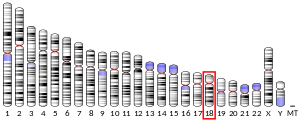Retinal homeobox protein Rx also known as retina and anterior neural fold homeobox is a protein that in humans is encoded by the RAX gene. The RAX gene is located on chromosome 18 in humans, mice, and rats.
Function
This gene encodes a homeobox-containing transcription factor that functions in eye development. The gene is expressed early in the eye primordia, and is required for retinal cell fate determination and also regulates stem cell proliferation.
Towards the end of late gastrulation a single eye field has formed and splits into bilateral fields via action by the signaling molecule, sonic hedgehog (Shh) secreted from the forebrain. Rax and Six-3 (also a transcription factor) maintain the forebrain's ability to secrete Shh by inhibiting activity of the signaling molecule Wnt.
Rax (Retina and Anterior Neural Fold Homeobox) is a gene in the OAR (Otx, Arx,& Rax) subgroup of the paired-like homeodomain family of transcription factors. Discovered in 1997, the Rax gene is known to contribute to the development of the retina, hypothalamus, pineal gland and pituitary gland.
Clinical significance
Mutations in this gene have been reported in patients with defects in ocular development, including microphthalmia, anophthalmia, and coloboma.
Mutations to the Rax gene cause malformation of the retinal field, including anophthalmia and microphthalmia.
Individuals who have a mutation in the RAX gene fail to develop ocular structures, referred to as anophthalmia. RAX mutant individuals can also have microphthalmia, where one or both of the eyes is smaller than normal.
Animal studies
Rax genes are conserved among vertebrates. RAX knockout mice have no eyes and abnormal forebrain formation. In the frog Xenopus tropicalis, Rax mutants are eyeless; the future retinal tissue instead has diencephalon and telencephalon features. Due to a genome duplication at the basis of the teleost fish lineage, fishes contain three Rax genes: Rx1, Rx2, and Rx3. Zebrafish and medaka mutants in Rx3 are eyeless.
References
- ^ GRCh38: Ensembl release 89: ENSG00000134438 – Ensembl, May 2017
- ^ GRCm38: Ensembl release 89: ENSMUSG00000024518 – Ensembl, May 2017
- "Human PubMed Reference:". National Center for Biotechnology Information, U.S. National Library of Medicine.
- "Mouse PubMed Reference:". National Center for Biotechnology Information, U.S. National Library of Medicine.
- ^ "Entrez Gene: Retina and anterior neural fold homeobox".
- ^ Muranishi Y, Terada K, Furukawa T (April 2012). "An essential role for Rax in retina and neuroendocrine system development". Development, Growth & Differentiation. 54 (3): 341–348. doi:10.1111/j.1440-169X.2012.01337.x. PMID 22524605. S2CID 20066919.
- ^ Carlson DM (2014). "Sense Organs". Human Embryology and Developmental Biology (5th ed.). Elsevier/Saunders. pp. 270–71. ISBN 978-1-4557-2794-0.
- Furukawa T, Kozak CA, Cepko CL (April 1997). "rax, a novel paired-type homeobox gene, shows expression in the anterior neural fold and developing retina". Proceedings of the National Academy of Sciences of the United States of America. 94 (7): 3088–3093. Bibcode:1997PNAS...94.3088F. doi:10.1073/pnas.94.7.3088. PMC 20326. PMID 9096350.
- Mathers PH, Grinberg A, Mahon KA, Jamrich M (June 1997). "The Rx homeobox gene is essential for vertebrate eye development". Nature. 387 (6633): 603–607. Bibcode:1997Natur.387..603M. doi:10.1038/42475. PMID 9177348. S2CID 4284692.
- Voronina VA, Kozhemyakina EA, O'Kernick CM, Kahn ND, Wenger SL, Linberg JV, et al. (February 2004). "Mutations in the human RAX homeobox gene in a patient with anophthalmia and sclerocornea". Human Molecular Genetics. 13 (3): 315–322. doi:10.1093/hmg/ddh025. PMID 14662654.
- Fish MB, Nakayama T, Fisher M, Hirsch N, Cox A, Reeder R, et al. (November 2014). "Xenopus mutant reveals necessity of rax for specifying the eye field which otherwise forms tissue with telencephalic and diencephalic character". Developmental Biology. 395 (2): 317–330. doi:10.1016/j.ydbio.2014.09.004. PMC 4267880. PMID 25224223.
- ^ Furutani-Seiki M, Wittbrodt J (July 2004). "Medaka and zebrafish, an evolutionary twin study". Mechanisms of Development. 121 (7–8): 629–637. doi:10.1016/j.mod.2004.05.010. PMID 15210172. S2CID 1798545.
- Loosli F, Staub W, Finger-Baier KC, Ober EA, Verkade H, Wittbrodt J, et al. (September 2003). "Loss of eyes in zebrafish caused by mutation of chokh/rx3". EMBO Reports. 4 (9): 894–899. doi:10.1038/sj.embor.embor919. PMC 1326357. PMID 12947416.
This article incorporates text from the United States National Library of Medicine, which is in the public domain.
| Transcription factors and intracellular receptors | |||||||||||||||||||||||||||||||
|---|---|---|---|---|---|---|---|---|---|---|---|---|---|---|---|---|---|---|---|---|---|---|---|---|---|---|---|---|---|---|---|
| |||||||||||||||||||||||||||||||
| |||||||||||||||||||||||||||||||
| |||||||||||||||||||||||||||||||
| |||||||||||||||||||||||||||||||
| |||||||||||||||||||||||||||||||
| see also transcription factor/coregulator deficiencies | |||||||||||||||||||||||||||||||
This article on a gene on human chromosome 18 is a stub. You can help Misplaced Pages by expanding it. |



